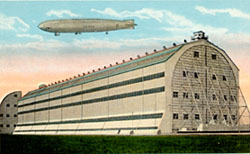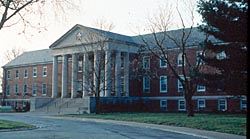
Scott Field began when Shiloh Valley Township, Illinois, leased 640 acres to the War Department for use as an aviation site in June 1917. The War Department named the site after Corporal Frank S. Scot--the first enlisted man to die in an aircraft accident--on July 10, 1917. The layout of Scott Field was typical of aviation fields built during World War I. Construction began in June 1917, and the Unit Construction Company was required by the Signal Corps to build approximately 60 buildings, lay a mile-long railway spur to connect the field with a main line on the Southern Railroad and level off an airfield in 60 days. Scott Field began as an aviation-training field for World War I pilots in August 1917 when the 11th and 21st Aero Squadrons from Kelly Field, Texas, arrived. Later the 85th and 86th squadrons arrived, and more than 300 pilots and many ground units were trained for service by the war's end in 1918. Flying was discontinued at Scott Field after the war and the base population dropped. The War Department purchased Scott Field in 1919 for $119, 285.84
Scott Field was transformed into a lighter-than-air (LTA) station in 1921. Lighter-than-air ships were used at Scott Field to research the capabilities of aerial photography, meteorology and conduct altitude experiments. In the late 1920s, emphasis shifted from airships to balloons. In 1929, the 12th Airship Company was deactivated and replaced the next day by the 1st Balloon Company. Airplanes began to dominate activities at Scott Field, and in 1937, the lighter-than-air activities officially came to an end. Scott Field's central location was advantageous when it was considered for the relocation site of the General Headquarters Air Force, which managed the combat arm of the U.S. Army. Scott Field grew from 628 acres in 1938 to 1,882 acres in 1939. Most of the frame World War I and lighter-than-air constructions were torn down--only a few, such as the 9th Airstrip Squadron headquarters/barracks building, a brick theater and nine sets of brick noncommissioned officers' quarters at the south end of the field were saved.

New housing, industrial and administrative buildings were completed by May 1939. The expansion program continued into 1940 with the construction of 21 more buildings, including a 200-man barracks, a 300,000-gallon elevated water tank, a 43-bed hospital, Hangar No. 1 and a General Headquarters Air Force office. During World War II Scott Field's main mission was to train radio operator-mechanics. By June 1945, Scott Field had trained 77,370 technicians who went on to be responsible for vital command and control communication throughout the Air Force. In January 1948, Scott Field was redesignated Scott Air Force Base. Scott AFB continued as a major training base for the Air Force until 1957. The 1405th Air Base Wing maintained the base properties and served as the base's home unit, which as of 1990 housed the 375th Military Airlift Wing.
Visit the National Park Service Travel American Aviation to learn more about Aviation related Historic Sites.
Last updated: August 29, 2017
